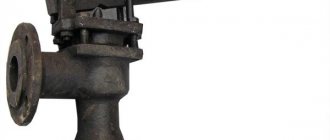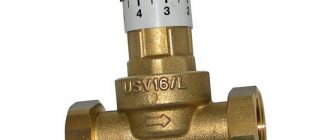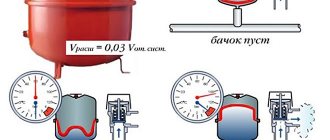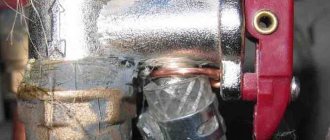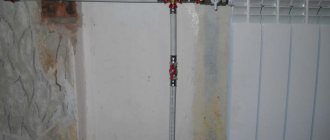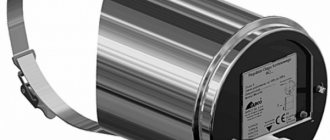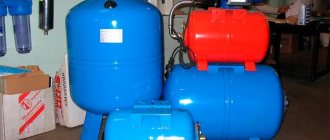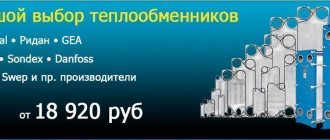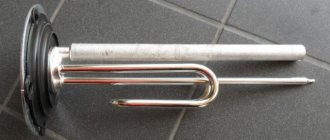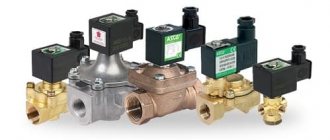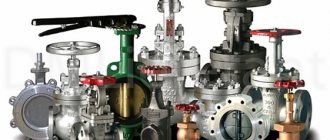Safety valves are necessary to relieve excess pressure in vessels, boilers, pipelines, heating systems, etc.
There are several types of safety valves differing in their operating principle. This information will not provide a comprehensive answer on how to choose a safety valve. To select a fuse, it is necessary to take into account not the operating principle, but many other characteristics: pressure, diameter, medium temperature, throughput, etc.
According to data from the book Calculation and design of pipeline fittings, the valve operation process can be divided into 5 stages:
- The first stage – the pressure is normal.
The pressure in the object and in the valve is equal to the working pressure, while the valve is closed tightly. - The second stage – the pressure increases
The pressure increases to Value P=K0P0, where K0 is the valve overload coefficient; P0 is the nominal (initial) pressure in the installation. In this case, the force in the spring is equal to the force from the medium pressure. Due to the disappearance of the force interaction between the sealing rings, intense leakage of the medium occurs in the absence of visible movement of the valve disc. - The third stage - pressure increase.
The pressure of the medium increases above K0P0, the valve plate rises above the seat and the passage of excess medium begins. As the pressure increases, the valve disc moves upward and the flow rate increases. - The fourth stage is pressure relief.
With the release, the pressure in the object decreases and reaches a value at which the valve disc seats on the seat. This pressure is usually lower than the pressure at which the poppet begins to rise and depends on the design of the relief valve. The valve plate sits on the seat; as the pressure decreases, the tightness of the valve lock increases and the leakage of the medium decreases. - Fifth stage - closing the valve
When the operating pressure is reached, the valve closes tightly and the leakage of the medium decreases.
How spring safety valves work
In spring-loaded valves, the pressure of the medium on the valve is opposed by the degree of compression of the spring. It is this that determines the actuation force, and the range of adjustments depends on the elasticity of the spring used.
The coolant exerts pressure on the spring, which compresses. When the set pressure is exceeded, the spool rises and the coolant is discharged through the outlet pipe. After the pressure in the system has dropped to the set pressure, the valve closes and the coolant drainage stops.
The response pressure of the spring safety valve is set by equipping the valve with various springs.
Many valves are manufactured with a special mechanism (lever, fungus, etc.) for manual detonation for control purging of the valve. This is done in order to check the functionality of the valve, since various problems may arise during operation, such as sticking or freezing of the spool to the seat.
Valve without manual release
Select valve
Manual release valve
With manual detonation
However, in industries using aggressive and toxic environments, high temperatures and pressures, control blowing can be very dangerous. Therefore, for spring valves used in such industries, the possibility of manual blowing is not provided and is even prohibited.
Video of the operation of a spring safety valve from the StroyNefteGaz channel
The spring safety valve is available in three versions:
- Low-lift devices are suitable for gas and steam pipeline systems, the pressure in which does not exceed 0.6 MPa. The lifting height of such a valve does not reach more than 1/20 of the seat diameter
- Medium-lift devices in which the spool lift height is from 1/6 to 1/10 of the nozzle diameter.
- Full-lift devices in which the valve lift height reaches up to ¼ of the seat diameter.
valves
For steam boilers
- For steam boilers
- For hot water
-16%
Compare
Close
Valves T-31MS Du50
RUB 50,000.00 RUB 42,000.00
The T-31MS Du50 safety valve is used in the industrial sector, heat power engineering and public utilities to protect steam pipelines and boilers in general from damage and ruptures due to exceeding the operating pressure of the environment. Developed by the TKZ plant to complete steam boilers.
Add to favorites
Add to order
Quick view
-19%
Compare
Close
Valves T-131MS Du50
RUB 58,000.00 RUB 47,000.00
Spring safety valve T-131MS Du50 is designed to protect equipment and pipelines from unacceptable pressure increases by releasing excess working fluid. Developed by the TKZ plant to complete steam boilers.
Add to favorites
Add to order
Quick view
-13%
Compare
Close
Valves T-32MS Du80
RUB 57,000.00 RUB 49,800.00
The T-32MS safety valve is used to prevent damage and destruction of elements of technical systems by releasing excess medium pressure in the pipeline. Developed by the TKZ plant to complete steam boilers.
Add to favorites
Add to order
Quick view
Load previous products
Load the following products
Heating safety valves
In addition to the heating bypass valve, the normal operation of the system requires the installation of other types of control and safety valves.
During heating operation, excess air may appear and the coolant will move back. To prevent these phenomena, it is necessary to provide in advance the installation of an air valve for heating and return. Types of safety valves
Depending on the functional purpose, there are two types of safety valves - to remove air from the system and to prevent the reverse movement of water in the pipes. Without these elements, the operation of the system may be unstable, which will lead to a violation of the temperature regime, destabilization of pressure and the creation of emergency situations.
- In places with the highest probability of excess pressure - after boilers, circulation pumps, on collectors;
- A heating ball valve or its petal equivalent must be mounted on the return pipe. It is also necessary to install this component in the circulation pump piping;
- At the highest point of the circuit - to remove air from the system. A Mayevsky tap is installed on radiators and batteries.
Safety valves must not impair the performance of the heating system. First of all, they eliminate possible malfunctions in the heat supply. In the “inactive” state, these system components should not impair the speed of movement of the coolant or affect the temperature regime.
Heating air valve
During heating operation, air pockets may form in pipes and radiators. The reason for this is the high oxygen content in the water and the coolant temperature above +100°C. As a result, oxidation of metal components occurs and the temperature distribution changes. To avoid these situations, it is necessary to install valves to bleed air from the heating system.
Working principle of the air valve
First of all, the air valve for heat supply is mounted in the safety group along with the drain and pressure gauge. In the heating circuit they are located on a straight branch leading from the boiler. This place has the highest coolant temperature, as well as maximum pressure. In the manifold circuit, it is mandatory to install heat supply drain valves on each comb.
- Mayevsky crane. Installed in the radiator (battery) and needed to remove air pockets;
- Automatic air vent. Mounted at the highest point of the system, as well as in security groups. Air from the heating system escapes through it.
For the latest model, it is important to comply with the operating conditions. After a long period of inactivity, there is a high probability that some moving components will “stick” and then the air vent will not work.
To avoid this, the structure should be regularly inspected and, if necessary, replaced with a new one.
Heating check valve
In gravity systems and in heating schemes without a circulation pump, there is always the possibility of a change in the direction of water movement. In this case, the boiler heat exchanger may be damaged due to overheating, as well as failure of other components. To prevent such situations, a check valve is installed.
Operating principle of a check valve
In large heating circuits, a heat supply ball valve is installed. Under the influence of the reverse flow of water, the polymer ball blocks the pipeline, thereby preventing the movement of the coolant. As soon as the direction changes, it falls down under the influence of gravity. The solenoid valve for the heating system works on the same principle. The difference lies in the control element - a solenoid or an electromagnetic coil is used for this.
The advantages of installing a solenoid valve in a heating system are as follows:
- Possibility of connection to the programmer;
- Setting the operation mode of the device depending on external factors - temperature or pressure;
- Reliability of operation.
The disadvantage of solenoid valves in heat supply is their dependence on the supply of electricity. In autonomous heating, a spring version of the check valve is used. The water pressure constantly acts on the saddle, compressing the spring. As soon as the direction changes, the movement of the coolant will be automatically blocked.
Magnetic spring safety valves
Magnetic spring safety valves use an electromagnetic actuator. The electromagnet provides additional pressing of the spool to the seat.
When the response pressure is reached, the electromagnet turns off and only the spring counteracts the pressure, and the valve begins to operate like a regular spring valve. Also, the electromagnet can create an opening force, that is, counteract the spring and force the valve to open.
There are valves in which the electromagnetic drive provides both additional pressing and opening force; in this case, the spring serves as a safety net in case of power failure.
Magnetic spring valves are typically used in complex impulse safety devices as control or impulse valves.
Why are valves on batteries needed?
Valves are also installed on radiators and circuit batteries, but their main function is to remove air from the system.
The installed valve for the heating radiator can be manual or automatic. The manual valve is opened and closed manually using a key and screwdriver.
The automatic valve on the heating radiator does not require human intervention. It removes air perfectly, but its main drawback is its sensitivity to blockages due to contamination of the coolant. To remove dissolved air from the coolant and clean it of dirt and sludge, it is recommended to install air separators.
- How to fill water into an open and closed heating system?
- Popular floor-standing gas boiler made in Russia
- How to properly bleed air from a heating radiator?
- Expansion tank for closed heating: device and principle of operation
- Gas double-circuit wall-mounted boiler Navien: error codes for malfunctions
Recommended reading
Bypass in a heating system - what is it and why is it necessary? Expansion membrane tank for a heating system: structure and functions How to accurately choose an expansion tank for heating? Heating thermostat - operating principle of different types
2016–2017 — Leading heating portal. All rights reserved and protected by law
Copying site materials is prohibited. Any copyright infringement will result in legal liability. Contacts
Main types of valves and their purpose
All safety products may differ from each other in a number of parameters, depending on the design features, namely:
- By type of closing valve:
- proportional;
- two-position.
- According to the lifting height of the closing organ:
- low-lift;
- mid-lift;
- full lift.
- Depending on the type of load on the spool:
- spring;
- lever;
- lever-spring;
- magnetic-spring.
Also, safety valves can differ in the nature of their operation and can be direct or indirect acting devices. The former are considered classic safety mechanisms, while the latter belong to the class of impulse devices. The most commonly used modification in industry is the spring-type corner safety choke.
High pressure (or rather its excess) can occur in the system for various reasons, caused by physical internal processes or other external factors, such as:
- equipment malfunctions;
- unwanted heat input from outside;
- errors when assembling the thermomechanical circuit. A safety valve is often installed in areas where such complications are likely to occur. These devices are compatible with almost any equipment, but they are most in demand when used with household or industrial tanks operating under high pressure conditions.
How to choose a new product
The need to purchase a new hydraulic valve may arise in the following cases:
- you are buying a used boiler without accessories;
- when moving the water heater to another location, the valve was lost;
- the valve is faulty and cannot be repaired.
If the documentation for the device has been preserved, then there are no problems with purchasing a new one. The main criterion for selection is the setting pressure of the safety part, which is indicated in the operating instructions. This parameter is usually indicated on housings in MPa, for example 0.7 MPa, which is 7 bar or atmospheres. All that remains is to choose a product with suitable thread sizes so that they match the threads on the boiler.
Safety valves for large-volume boilers Source stroychik.ru
In the case where there is no documentation and the old valve is missing, choosing a new one is a little more difficult. First of all, you need to try to find its technical data on the Internet using the device designation. If this could not be done, perhaps the designation plate has worn off or fallen off over time, then it is better to install a hydraulic valve with adjustment to a small pressure, for example 0.8 MPa.
If this is not enough, and your valve constantly works and dumps water, not allowing it to heat up, then there are two options. Either reduce the heating temperature or change it to a higher setting. As an option in this case, you can use a bypass valve complete with a non-return valve. It has manual adjustment and with its help you can select the necessary operating pressure parameters.
